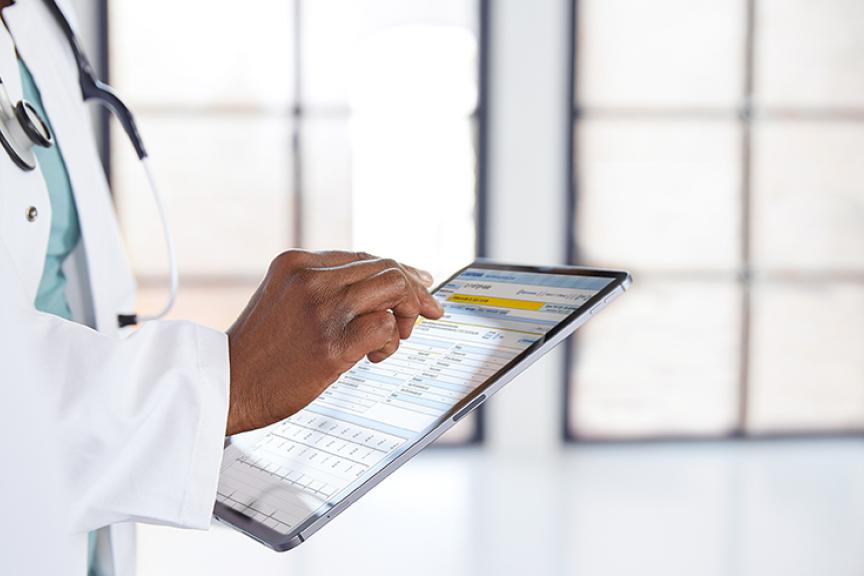Advancing Cardiac Patient Management Together
Digital Health brings opportunities to advance patient care but also new challenges. In addition to a marked increase in data volume in the clinical space and increased patient involvement in care, digital technology’s role in the care space has changed. This also allows enormous opportunities for early detection and preventing clinical problems, particularly for patients with an implanted cardiac device—when data and new digital technologies are optimally managed.

We caught up with BIOTRONIK Chief Medical Officer Dr. David Hayes to get his insights on managing the clinical data flood, involving better-informed patients, and opportunities for digital health collaboration between clinicians and industry..
Dr. Hayes, you spent more than four decades with the Mayo Clinic in Rochester, Minnesota, dedicated to treating patients and helping advance electrophysiology and cardiology. How did you see post-implantation care change over the years?
Follow-up care has changed dramatically during the decades I’ve been involved. Without question, the most significant change was the development of remote monitoring, which started with BIOTRONIK Home Monitoring in 2001. As a result of this dependable and convenient method of assessing the patient’s device remotely, professional societies established guidelines for device follow-up frequency. That allowed issues requiring clinical action to be detected and acted upon earlier. As a result of more compliant follow-up and earlier attention to important device-related clinical issues, Home Monitoring has FDA claims for mortality reduction, early detection of potentially significant and actionable clinical issues, and reduction of “in-office” follow-up.
What Makes Post-implantation Patient Care Challenging for Healthcare Professionals?
Historically I would say there were two primary challenges, but one of those has been largely overcome by BIOTRONIK Home Monitoring – and that is patient compliance. In the early days of remote monitoring, most companies would instruct the patient in remote monitoring at the time of implant and then either send the monitor home with the patient or mail it to them later. The remote monitoring equipment then had to be “paired” with the patient. Between having forgotten the home monitoring equipment hook-up instructions and delays in receiving the equipment, compliance wasn’t always very good – so we had many data gaps. BIOTRONIK Home Monitoring took a different approach. The patient took their “messenger” transmission device with them, it didn’t require pairing, and it didn’t require that they have a separate landline. So, BIOTRONIK HM compliance has been demonstrated to be > 90 percent, largely because it simplified remote monitoring’s implementation.
That seems like a long time ago now. Today, we’re dealing more with the issue of being overwhelmed with data at times—rather than dealing with the gaps we saw back then. The main remaining challenge for healthcare professionals is managing all this data. However, that too is becoming easier and less burdensome with new systems that assist with data management, EHR compatibility, and so forth.
What Role Do Digital Health Technologies Play in the Everyday Patient Care Journey?
The simple answer is that the role of digital health in routine patient care is rapidly increasing. Even when I left everyday clinical practice two years ago, patients were bringing or sending in rhythm tracings they had collected from their smartwatch or other commercially available tools that could collect and transmit an ECG tracing. As wearables continue to improve—and they will—the data will become increasingly relevant. Whether the data is considered ”medical grade” or not, much of the information will be clinically relevant.
When increasingly available sources of digital health data met the pandemic, the whole discipline moved forward at warp speed; much faster than it would have in the absence of the pandemic.
In the Future and in an Ideal Scenario, How Would Clinical Practitioners Use Data for Making Clinical Decisions in Caring for Cardiac Patients?
Depending on the quality of digital data collected and transmitted, the data will likely become a mainstay of chronic disease management. Even currently, if a patient were to transmit a tracing to their physician that they got on their smartwatch or other digital recording devices—and that tracing showed a symptomatic episode of atrial fibrillation—based on symptoms or duration of the episode, it could result in the physician initiating treatment earlier. Without the digital recording device, the patient would have needed to make an appointment, obtain monitoring equipment, and wait to see if another episode was captured while the monitoring was performed. Only then would they see their physician again and have therapies considered.
On World Heart Day, Let’s Also Talk About the Role of Patients. Patients With a Cardiac Implant Are Becoming Increasingly Digitally Empowered and More Proactive in Their Healthcare. How Does That Impact the Clinician’s Work?
Overall, it’s a definite plus. Empowered patients and better-informed patients make both interactions and outcomes more positive. When it comes to being digitally empowered, there is a bell-shaped curve of patient “empowerment” as one would expect. There are some patients who remain very much “need to know only” and “I do whatever my doctor advises,” to the other end of the spectrum where patients want every detail they can obtain regarding their medical information. Those patients can require more time from the physician, but if the information can be appropriately distilled, packaged, and used, the end result should be a positive one.
Where Would Post-implantation Care Potentially Benefit From Greater Digital Patient Engagement?
We will see a greater benefit when we effectively get device data to the patient in an understandable way. Now that most healthcare organizations provide patient portals, we have seen a steady increase in patients accessing their data and relying on digital approaches for making appointments, renewing medications, asking simple questions, and getting telehealth diagnoses and treatment that would have otherwise required an “in-office” visit. Depending on the patient portal, some patients can view device-related information. However, the real benefit for patients will occur when we can appropriately package the data and provide it via a digital application or smartphone app. Such apps already exist, but there will be a learning curve for figuring out the optimal way of distilling and presenting that information in a way any given patient can understand. A document by Dr. Eric Topol beautifully explores how to prepare healthcare providers with education and training to deliver the digital future.
What Is the Medtech Industry’s Role in Advancing Cardiac Patient Management? And What Should We Specifically Expect From Biotronik on This?
First and foremost, the industry needs to provide the necessary tools. Specifically, Home Monitoring as currently provided, allows daily transmissions of data for the patient and then distills, organizes, and provides the data to the patient via an easy to use “app” or other digital access.
Next, in order to know how to most effectively organize and provide device data to the patient—we need more collaboration between industry, the medical community, patients, and established patient advocacy organizations. A serious effort needs to be made to find out what specific information would be helpful to physicians other than those directly involved in device follow-up, because many types of physicians will have interactions with device patients other than the electrophysiologist or clinician in the device follow-up clinic. These include primary care physicians, general internists, obstetricians, hospitalists, neurologists, heart failure specialists, and more. What these physicians would like to see will depend on their type of interaction and their clinical interests. “One size” will not “fit all,” so we will need to elicit their input as we strive to improve collaboration with industry and patients.
Thank you very much, Dr. Hayes.
Dr. Hayes’ answers show the need for adequate disease management – with and for patients and physicians. We at BIOTRONIK are dedicated to addressing physicians' challenges and advancing cardiac patient management.
Read more about our one portfolio of products and services for disease management – the BIOTRONIK CardioSphere.


